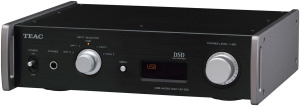More zeros and ones
I have had the pleasure of auditioning and reviewing several good sounding digital-to-analog converters this year, ranging in price from a low of $189 (iFi-audio Nano iDSD, iFi-audio Micro iDAC, $299, iFi-audio Micro iTube/Pre-amplifier, $299) to a high of $1,790 (B.M.C. PureDAC). I can now include the $849 Teac UD-501 to this group of high-value achievers.
The UD-501 is part of Teac’s Reference Series. It is a dual-monaural USB D/A converter with headphone amplifier. My colleague Jack Roberts is auditioning several other components in the Reference Series, including the UD-501, and will impart his thoughts after this review.
Each component in the Reference series is packed with some of the latest digital technology aimed at the modern day audio user and best of all, each is reasonably priced.
Double the pleasure times two
One can get the UD-501 in any color one wishes, as long as it is either in silver or black. My review unit is in black with aluminum side-panels, and appears to be sturdy and solidly built with heft in a compact size. The chassis itself is made of steel. Like other components in the Reference Series, the UD-501 is housed in a much smaller enclosure than the traditional rack-mount size, measuring eleven and a half inches in length, nine inches in depth and three inches in height. While not nearly as small as the iFi-audio Micro and Nano devices I recently reviewed, any component of the Reference series should fit into most tight spaces. The rack handles look nice but are merely decorative and ornamental since they are way too small for my fingers to fit through the cutouts of the handles.
The black front panel is elegantly simple, fitted with the necessary items for proper operation: power on/off switch, input selector knob, standard ¼ inch headphone jack, menu button (used in conjunction with the input selector), menu/playback information display, and headphone volume knob. No remote control is offered, so you have to go the old school route by getting off your duff to change settings. Around back, there are input and output connections everywhere. Teac seems to like offering everything in twos. There are two coaxial inputs, two optical inputs, and two sets of fixed outputs (RCA and XLR), but only one USB input. Since I’m a card carrying tree hugger, I was glad to see a power save switch, which automatically makes the unit go into standby after 30 minutes of inactivity. Two methods are available to turn the power back on-there we go with the twos theme again-either by pressing the menu button and then turning the input selector, or, turning the power button to off, waiting a few seconds and turning it back on. An AC receptacle completes the back panel picture.
The UD-501 is a true dual-monaural design, with two discrete circuits (from toroidal power transformers to output sections), and two Burr-Brown PCM 1975 32-bit chipsets, one per channel performing the conversions. In addition, four MUSES8920 op-amps (two per channel), specifically designed to produce dimensionally in hi-fi were selected for this component. There are several other technical wizardries which I won’t discuss here, but techno junkies can glean them at the company website.
The supplied AC cord is detachable so one can substitute freely with an UL approved cord. Also included is a pair of generic RCA interconnects and an owner’s manual.
In the past two years or so, there have been an increasing number of digital-to-analog converters which are able to support high-resolution music in its various formats (PCM, DXD, DSD), and the Teac UD-501 is no exception. The UD-501 sampling capability rates as listed on the Teac website:
– Supports DSD 2.8/5.6MHz playback (via USB)
– Supports PCM 32bit/384kHz playback (via USB)
– Supports PCM 24bit/192kHz playback (Coaxial)
– Supports up to 24bit/96kHz playback (Optical)
– Supports DSD native playback by ASIO2.1 or DoP method
While it’s great to offer so many playback sampling options, what I was really interested in experimenting are the four analog filters for DSD (via USB) and the three digital filters for PCM (via USB), which allow for shaping the playback sound. There are actually only two selectable filters for PCM playback, the third option being no filter. I will describe the changes in sound produced by the filters later.
If any listener happens to favor up-sampling their 44.1 kHz Redbook file-or heaven forbid, MP3-the UD-501 has a useful feature to do just that, up to 192 kHz. Another useful feature allows for dimming the display or completely turning it off.
And for anyone who does not have a music player capable of DSD or DXD playback, a free simple high-resolution music player is available on their website, capable of supporting up to 384kHz in PCM/DXD and 5.6MHz in DSD. In case you missed it, I said free.
For Microsoft Windows OS users, the necessary driver can be downloaded from the company website utilizing ASIO 2.1 (no WASAPI available), while Apple Mac users are good to go without any download (DoP method).
- (Page 1 of 2)
- Next page →


The rack handles are more than just decorative, they help to protect the front panel in case the unit is droped.
I still have mine after almost 2 years, which is probably a record as far as keeping a piece of gear is concerned. I wrote a review of my experience with the UD-501 here:
http://audioreview.ca/default.aspx?pagename=review&reviewID=7660